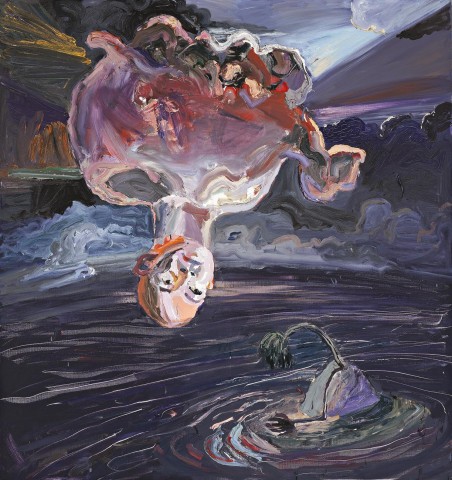SEROQUEL, 2013
BEN QUILTY
oil on linen
170.0 x 160.0 cm
signed, dated, and inscribed with title verso: Seroquel Ben Quilty 2013
Tolarno Galleries, Melbourne
Private collection, Sydney
The Fiji Wedding, Tolarno Galleries, Melbourne, 20 April – 1 June 2013
Flanagan, R., (et al.), Ben Quilty, Penguin Random House, Melbourne, 2019, pp. 173 (illus.), 346
Almost four hundred years ago, the English poet John Donne wrote the famous stanza ’no man is an island, entire of itself, every man is a piece of the continent’.1 This rallying call for empathy and solidarity amongst men and women is echoed in Ben Quilty’s oeuvre, following his restless transmutations from painterly skulls, babies and Toranas to grotesque portraits and desolate paintings of discarded life jackets, dense with pathos. As his current touring survey exhibition (currently on view at the Queensland Art Gallery and Gallery of Modern Art and opening at the Art Gallery of New South Wales in November) would attest, Quilty has reached an impressive level of recognition for a living Australian artist, which he has used judiciously to support numerous social causes. The most strident was his advocacy for clemency for Myuran Sukumaran, an Australian who, at the time was awaiting a death sentence in Bali.
In 2012, Quilty was posted as official Australian war artist to Tarin Kowt in Afghanistan, documenting in a series of portraits the psychological sequels of active service – paintings whose power Richard Flanagan described as ’impossible to dismiss or diminish’.2 With his distinctive impasto surface, Seroquel, 2013 was amongst the first paintings created after this series, contemplative and mysterious, yet still containing a Baconian torment in its floating figure.3 Displayed in a solo exhibition entitled Fiji Wedding, at Melbourne’s Tolarno Galleries, Seroquel belongs to a group of pictures in Quilty’s oeuvre that express discomfort with his place in the world, its privileges and responsibilities. Quilty was disturbed by the vast disparity of experience between his deployment and his participation in a luxurious destination wedding in Fiji, in a holiday resort removed from the poverty and squalor of the rest of the island and from pressing global concerns of social justice.
Amid the artifice and debauchery of Australians on tour, Quilty’s inquisitive figure is unsettled. One of only three portraits of Myuran painted by the artist, this figure is suspended from the sky, hovering upside down from a sanguine cloud, removed and observing the rippling black tides of contemporary history.4 With a restricted chromatic palette, Seroquel conveys the uncertainty of our times. The island crowned by a single drooping palm tree recurs in several paintings of 2013, including Survivor, Myuran and culminating in an expansive Rorschach painting The Island, exhibited in the 2014 Adelaide Biennial. Using this motif as a condensed metaphor for the trauma and displacement inherent in our island nation, Quilty presents Seroquel as a meditation on responsibility. The floating figure, caught in its thoughts, is however, unaware of the dawning patch of blue sky in the upper right. Quilty, after all, remains an optimist in the face of adversity.
1. Donne, J., Devotions, 1624
2. Flanagan R., (et al.), Ben Quilty, Penguin Random House, Melbourne, 2019, p. 20
3. Seroquel is the trade name of an antipsychotic medication used to treat mood disorders such as Schizophrenia and Post Traumatic Stress Disorder
4. conversation between the artist and Damian Hackett, 31 July 2019
LUCIE REEVES-SMITH
